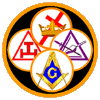The Origin of the Knights Templar

There are many historical accounts of the Poor Fellow-Soldiers of Jesus Christ, or Knights of the Temple, more commonly referred to as Knights Templar. They were formed as a result of the Crusades doing battle with the Moslems and the capture of Jerusalem around 1099. Jerusalem fell and the Holy City belonged to the Crusaders and all Christendom rejoiced. Most libraries and bookstores have many volumes on the Crusades and the Knights Templar and these writings are easily understood. The Internet today has an almost endless amount of information on Knights Templar and those interested can become well informed of the different versions relating to their history.
Men, women and children pressed forward on their pilgrimage to the sacred city only to find that although Jerusalem was in Christian hands, the Moslems still controlled Palestine.
The highways and byways leading to Jerusalem were unprotected. The ferocity of the Moslems seemed to increase with the fall of the city, and mutilated bodies and bleached bones of pilgrims soon became a common site along the roadways. To add to the vulnerability of the pilgrims, thousands of the Crusaders, their primary objective accomplished, returned to their own lands leaving the countryside to the Moslems uncontested.
This was the circumstance that set the stage for Templary. A small band of Crusaders remaining after the conquest recognized the plight of the pilgrims and bound themselves in a holy Brotherhood in arms, entering into a solemn agreement to aid one another in clearing the highways, and in protecting the pilgrims through the passes and defiles of the mountains to the Holy City
In short, the Knights Templar were laymen who protected and defended Christians traveling to Jerusalem. These men took vows of poverty, chastity and obedience, and were renowned for their fierceness and courage in battle.
In 1118 A.D., nineteen years after the successful Crusade, these Poor Fellow Soldiers of Jesus Christ, as they termed themselves, were officially recognized and sanctioned and were given for their headquarters, a building on Mount Moriah, the site of the former Temple of King Solomon. Consequently, they became known as the Knights of the Temple, or Knights Templar.
This was the era of chivalric ascendancy. Much as outstanding athletes receive the hero worship and admiration of the public today, so did those Knights of old capture the hearts and the wealth of the public of their period. Their fame spread like wildfire. Rulers hastened to be identified with Knights Templar and to present gold and property to the Order.
It is a matter of history that the warriors who fought for Christianity as Knights Templar had their vicissitudes with more downs than ups on the battlefield through the centuries. However, their wealth and their prestige remained undiminished. on the contrary their treasury became too large to escape the notice of some financially embarrassed rulers, especially Philip the Fair, King of France.
Philip the Fair with Pope Clement (who Philip pretty well influenced) arranged for Convocation of the Grand Master of the Knights Templar, Jacques DeMolay, and his officers at Paris. The Convocation was held, but Grand Master DeMolay and his officers never left, at least not with their lives. In 1314 Jacques DeMolay was burned at the stake for alleged heresy and dozens of other accusations; all Knight Templar wealth was seized and Templary “moved underground.”
Some have written that after the death of Grand Master DeMolay there was an unbroken succession of the Grand Masters and a constant Templar organization without a lapse. This is difficult to believe and it is even more difficult to read the many treatises written to support or disprove the theory.
To simplify the story without attempting to elaborate or quote various researchers, all we know is that when Templary emerged in the early 1700’s it was a part of Freemasonry. THERE IS NO PROOF OF DIRECT CONNECTION BETWEEN THE ANCIENT ORDER AND THE MODERN ORDER KNOWN TO DAY AS THE KNIGHTS TEMPLAR.